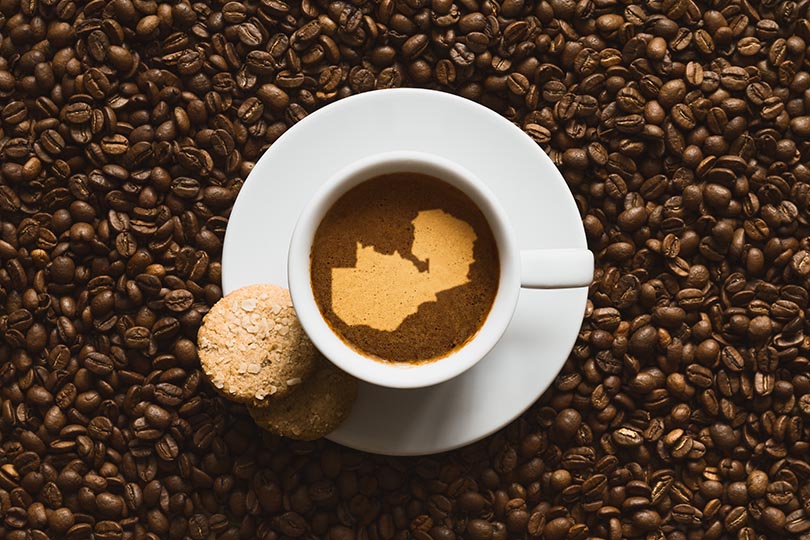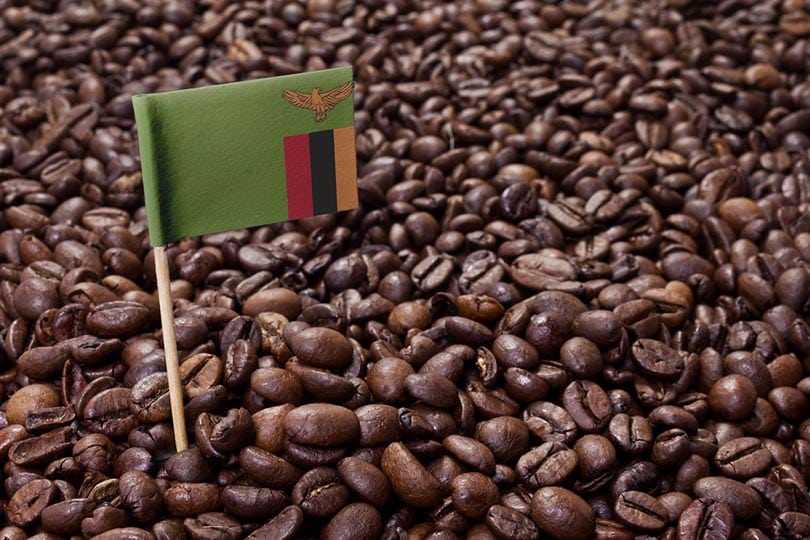
Zambia coffee is soaring in popularity. Known for its mild flavor and high quality, a cup of this lovely brew can be compared to some of the highest-end coffees on the market. If you’ve ever had a cup of this delicious coffee, you may be interested in a bit more information on Zambia, the growing process of their coffee beans, and the types of coffee they specialize in. If that’s the case, then you’ve come to the right place. Read on below for a complete guide to Zambia coffee and what this mild brew goes through to find its way to your cup.

The History of Coffee in Zambia
Coffee farms didn’t find their way to Zambia early on. It was in the 1950s when the first cultivar seeds landed in Zambia from Kenya and Tanzania. By this point, coffee was already big business in several parts of the world.
In the 1970s, more research into ways to increase the production of coffee in Zambia began. It was believed that rain-fed fields would prosper in the area. In the hopes of making all this possible, small coffee farmers began moving into the area and the growth of the Zambia coffee market took off.
By the 1980s, the International Coffee Organization gave Zambia a quota allowing them to export 350 tons of its coffee. In 1985, it all became official and Zambia became the exclusive exporter of Zambia coffee.

Types of Coffee in Zambia
Most likely you’ve heard of the two types of coffee grown in the province of Zambia. Robusta and Arabica beans are both popular in this area but Arabica, the traditional African organic coffee, is most popular in this part of the world. Here’s a bit of info on both of these amazing types of coffee beans.
Arabica

The Coffea arabica plant originated in Ethiopia. Arabica beans are quite popular throughout the world and are responsible for well over half the cups of coffee drank worldwide. Arabica coffee has a wide range of tastes which is one of the reasons so many people love to drink it. You can easily find a soft-sweet Arabica coffee or one with more kick and a sharp-tangy taste.
Arabica coffee is quite difficult to produce, which makes it one of the more expensive coffees on the market. In Zambia or other areas where Arabica is grown, certain conditions are required to yield a great bean. Subtropical climates are best suited for Arabica bean growth. Farmers also need rich soil, sun, shade, and lots of moisture. Possibly the most important thing needed to grow Arabica beans, however, is a high elevation. This is where the mountains of Zambia come into play.
Robusta

While not as popular in Zambia, you’ll still find Robusta coffee beans grown here. Robusta is derived from the Coffea canephora plant that originates in Africa. Mostly used in instant coffees and espressos, Robusta is known for having a more bitter taste than other coffees. Some compare the taste of Robusta to an oatmeal-type taste that is slightly harsh. Before roasted, these beans may give off a slight peanut smell.
Robusta coffee beans can be considered more resilient than Arabica beans. These plants can grow at lower altitudes, aren’t very susceptible to attacks by pests, and produce higher yields per acre at a decently low production cost.
The biggest disadvantage to Robusta plants is the technique used to grow them. Mono-cropping, the process of using the same land for the same plant yearly, is quite harsh on the environment. Considering these plants can be grown almost anywhere, large companies are known for clearing large areas of the rainforest for more fields to harvest. After years of these practices, the soil may be left unusable due to the lack of nutrients.

Where Zambia Coffee Grows
The mountains of Zambia are home to a majority of the coffee growth that takes place there. As mentioned above, Arabica is the most popular coffee grown in the region, and with the elevations required for the best growth, the Muchinga Mountains and the city of Lusaka are where the magic happens.
The Mountains of Muchinga and Lusaka are located in the Northern Province of Zambia. Within this province, you’ll find three main regions: Isoka, Kasama, and Nakonde. Within these regions, you’ll find several coffee estates where thousands of hectares of coffee are grown.
The main reason the Northern Province of Zambia is used for coffee growth is its nearness to the equator. This ideal location makes the conditions here perfect for both Arabica and Robusta beans and why Zambia coffee is now available to the masses.

Why Does Zambia Coffee Lose Its Flavor?
A perfect cup of Zambia coffee is brightly flavored and elegant. You will taste a few hints of citrus due to the dense body of the coffee. Unfortunately, though, if you’ve tried Zambia coffee, you may not have been a fan of the flavor. Why may your cup of Zambia be different from those of your friends? The answer to that question is simple—shipping.
Coffee can lose its flavor when sitting in storage. This is especially true of coffee shipped from far away. While the coffee you ordered, or expect to purchase at your favorite supermarket sits, waiting to be sent out from the port, the beans are losing their flavor.
When fresh, Zambia coffee is comparable to the highest-end coffees on the market. If you’re hoping to have a great cup of this coffee, consider who you order from. Read shipping information carefully and be aware of the length of time it may take to get your beans to your coffee maker.

The Final Word on Zambia Coffee
Coffee is a major export for Zambia. The growth of these coffee beans is also something farmers in the region take great pride in. If you’re a true coffee lover and want an elegant, high-quality bean in your cup, choosing Zambia coffee is a great idea. With one sip, you may find yourself a new favorite you simply can’t do without!
RELATED READS:
- Himalayan Coffee: A Complete Guide
- Honduran Coffee History, Tasting Notes & More
- All About Timor Coffee: History, Flavors, & Brewing Tips
Featured Image Credit: PatrikV, Shutterstock















